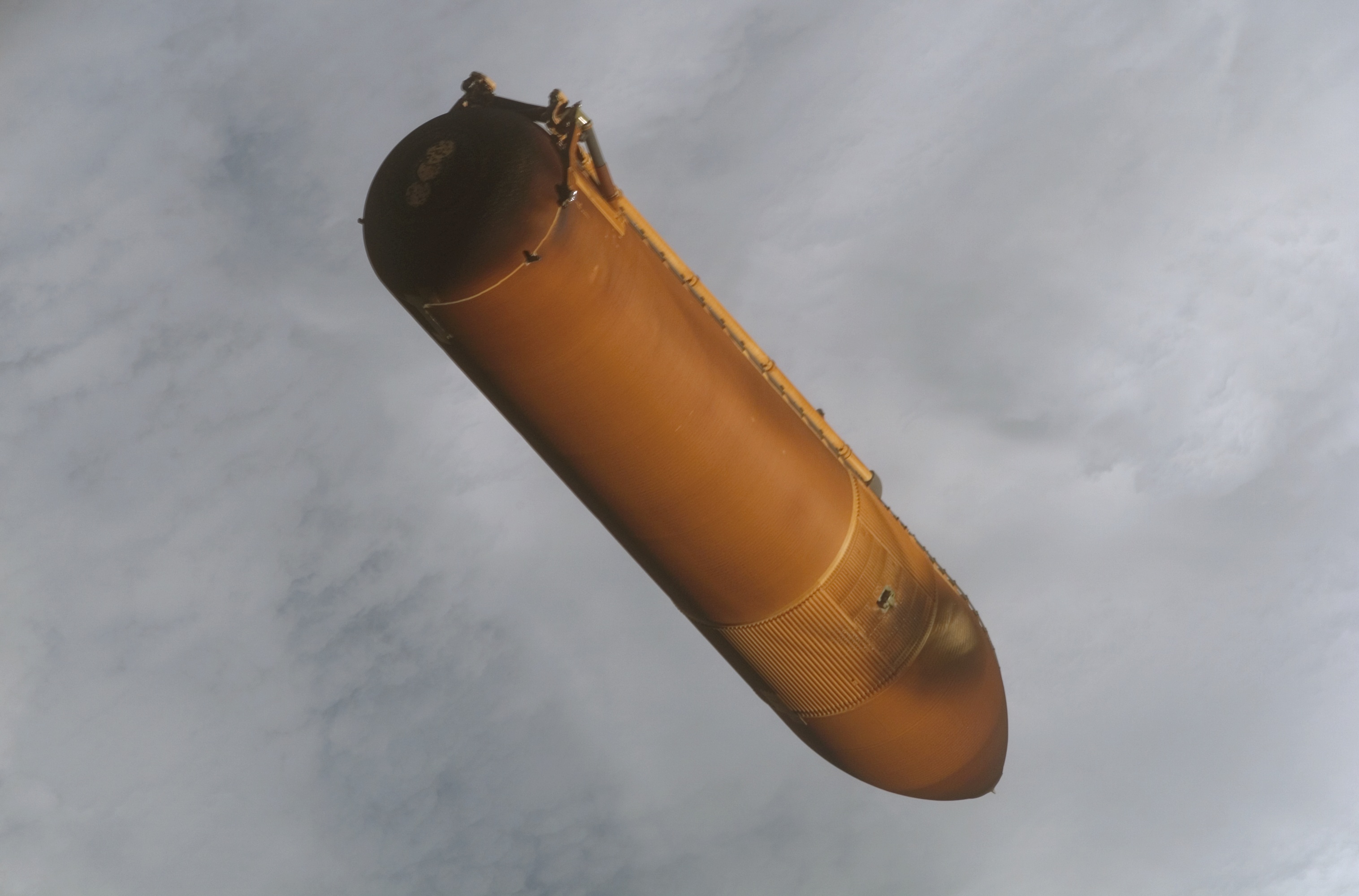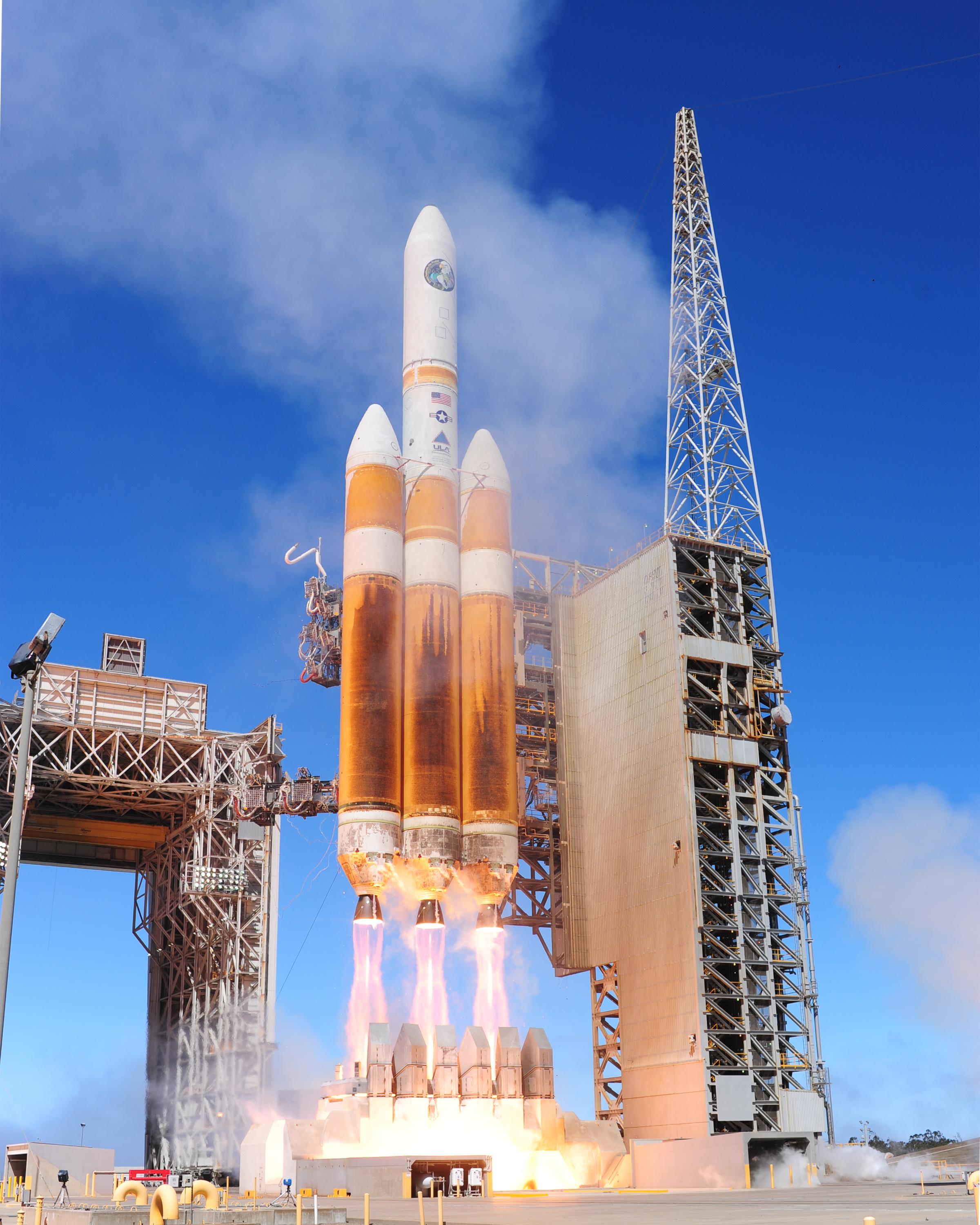|
SSME Powerhead
The RS-25, also known as the Space Shuttle Main Engine (SSME), is a liquid-fuel cryogenic rocket engine that was used on NASA's Space Shuttle and is used on the Space Launch System. Designed and manufactured in the United States by Rocketdyne (later Pratt & Whitney Rocketdyne and Aerojet Rocketdyne), the RS-25 burns cryogenic (very low temperature) liquid hydrogen and liquid oxygen propellants, with each engine producing thrust at liftoff. Although RS-25 heritage traces back to the 1960s, its concerted development began in the 1970s with the first flight, STS-1, on April 12, 1981. The RS-25 has undergone upgrades over its operational history to improve the engine's thrust, reliability, safety, and maintenance load. The engine produces a specific impulse (''I''sp) of 452 seconds (4.43 kN-sec/kg) in vacuum, or 366 seconds (3.59 kN-sec/kg) at sea level, has a mass of approximately , and is capable of throttling between 67% and 109% of its rated power level in one-pe ... [...More Info...] [...Related Items...] OR: [Wikipedia] [Google] [Baidu] |
Shock Diamond
Shock diamonds (also known as Mach diamonds or thrust diamonds, and less commonly Mach disks) are a formation of standing wave patterns that appear in the supersonic exhaust plume of an aerospace propulsion system, such as a supersonic jet engine, rocket, ramjet, or scramjet, when it is operated in an atmosphere. The "diamonds" are actually a complex flow field made visible by abrupt changes in local density and pressure as the exhaust passes through a series of standing shock waves and expansion fans. The physicist Ernst Mach was the first to describe a strong shock normal to the direction of fluid flow, the presence of which causes the diamond pattern. Mechanism Shock diamonds form when the supersonic exhaust from a propelling nozzle is slightly over-expanded, meaning that the static pressure of the gases exiting the nozzle is less than the ambient air pressure. The higher ambient pressure compresses the flow, and since the resulting pressure increase in the exhaust gas s ... [...More Info...] [...Related Items...] OR: [Wikipedia] [Google] [Baidu] |
Engine Throttle/output
An engine or motor is a machine designed to convert one or more forms of energy into mechanical energy. Available energy sources include potential energy (e.g. energy of the Earth's gravitational field as exploited in hydroelectric power generation), heat energy (e.g. geothermal), chemical energy, electric potential and nuclear energy (from nuclear fission or nuclear fusion). Many of these processes generate heat as an intermediate energy form; thus heat engines have special importance. Some natural processes, such as atmospheric convection cells convert environmental heat into motion (e.g. in the form of rising air currents). Mechanical energy is of particular importance in transportation, but also plays a role in many industrial processes such as cutting, grinding, crushing, and mixing. Mechanical heat engines convert heat into work via various thermodynamic processes. The internal combustion engine is perhaps the most common example of a mechanical heat engine in which heat ... [...More Info...] [...Related Items...] OR: [Wikipedia] [Google] [Baidu] |
Pogo Oscillation
Pogo oscillation is a self-excited vibration in liquid-propellant rocket engines caused by Rocket engine#Combustion instabilities, combustion instability. The unstable combustion results in variations of engine thrust, causing variations of acceleration on the vehicle's flexible structure, which in turn cause variations in propellant pressure and flow rate, closing the self-excitation cycle. The name is a metaphor comparing the Flight control surfaces#Longitudinal axis, longitudinal vibration to the bouncing of a pogo stick. Pogo oscillation places stress on the frame of the vehicle, which in severe cases can be dangerous. Origin NASA Associate Administrator for Manned Space Flight George Mueller (NASA), George Mueller explained Apollo 6's pogo oscillation to a congressional hearing: In general, pogo oscillation occurs when a surge in combustion chamber pressure increases back pressure against the fuel coming into the engine. This reduces fuel flow and thus chamber pressure. ... [...More Info...] [...Related Items...] OR: [Wikipedia] [Google] [Baidu] |
Heat Exchanger
A heat exchanger is a system used to transfer heat between a source and a working fluid. Heat exchangers are used in both cooling and heating processes. The fluids may be separated by a solid wall to prevent mixing or they may be in direct contact. They are widely used in space heating, refrigeration, air conditioning, power stations, chemical plants, Petrochemical, petrochemical plants, Oil refinery, petroleum refineries, natural-gas processing, and sewage treatment. The classic example of a heat exchanger is found in an internal combustion engine in which a circulating fluid known as engine coolant flows through radiator coils and air flows past the coils, which cools the coolant and heats the incoming air. Another example is the heat sink, which is a passive heat exchanger that transfers the heat generated by an electronic or a mechanical device to a fluid medium, often air or a liquid coolant. Flow arrangement There are three primary classifications of heat exchangers accord ... [...More Info...] [...Related Items...] OR: [Wikipedia] [Google] [Baidu] |
Turbopump
A turbopump is a fluid pump with two main components: a rotodynamic pump and a driving gas turbine, usually both mounted on the same shaft, or sometimes geared together. They were initially developed in Germany in the early 1940s. The most common purpose of a turbopump is to produce a high-pressure fluid for feeding a combustion chamber. While other use cases exist, they are most commonly found in liquid rocket engines. There are two common types of pumps used in turbopumps: a centrifugal pump, where the pumping is done by throwing fluid outward at high speed, or an axial-flow pump, where alternating rotating and static blades progressively raise the pressure of a fluid. Axial-flow pumps have small diameters but give relatively modest pressure increases. Although multiple compression stages are needed, axial flow pumps work well with low-density fluids. Centrifugal pumps are far more powerful for high-density fluids but require large diameters for low-density fluids. Histo ... [...More Info...] [...Related Items...] OR: [Wikipedia] [Google] [Baidu] |
Space Shuttle Orbiter
The Space Shuttle orbiter is the spaceplane component of the Space Shuttle, a partially reusable launch system, reusable orbital spaceflight, orbital spacecraft system that was part of the discontinued Space Shuttle program. Operated from 1981 to 2011 by NASA, the U.S. space agency, this vehicle could carry astronauts and payloads into low Earth orbit, perform in-space operations, then atmospheric entry, re-enter the atmosphere and land as a glider aircraft, glider, returning its crew and any on-board payload to the Earth. Six orbiters were built for flight: ''Space Shuttle Enterprise, Enterprise'', ''Space Shuttle Columbia, Columbia'', ''Space Shuttle Challenger, Challenger'', ''Space Shuttle Discovery, Discovery'', ''Space Shuttle Atlantis, Atlantis'', and ''Space Shuttle Endeavour, Endeavour''. All were built in Palmdale, California, by the Pittsburgh, Pennsylvania-based Rockwell International company's North American Aircraft Operations branch. The first orbiter, ''Enterpris ... [...More Info...] [...Related Items...] OR: [Wikipedia] [Google] [Baidu] |
Space Shuttle External Tank
The Space Shuttle external tank (ET) was the component of the Space Shuttle launch vehicle that contained the liquid hydrogen fuel and liquid oxygen oxidizer. During lift-off and ascent it supplied the fuel and oxidizer under pressure to the three RS-25 main engines in the orbiter. The ET was jettisoned just over 10 seconds after main engine cut-off (MECO) and it re-entered the Earth's atmosphere. Unlike the Solid Rocket Boosters, external tanks were not re-used. They broke up before impact in the Indian Ocean (or Pacific Ocean in the case of direct-insertion launch trajectories), away from shipping lanes and were not recovered. Overview The ET was the largest element of the Space Shuttle, and when loaded, it was also the heaviest. It consisted of three major components: * the forward liquid oxygen (LOX) tank * an unpressurized intertank that contains most of the electrical components * the aft liquid hydrogen (LH2) tank; this was the largest part, but it was relatively l ... [...More Info...] [...Related Items...] OR: [Wikipedia] [Google] [Baidu] |
Oxidizing Agent
An oxidizing agent (also known as an oxidant, oxidizer, electron recipient, or electron acceptor) is a substance in a redox chemical reaction that gains or " accepts"/"receives" an electron from a (called the , , or ''electron donor''). In other words, an oxidizer is any substance that oxidizes another substance. The oxidation state, which describes the degree of loss of electrons, of the oxidizer decreases while that of the reductant increases; this is expressed by saying that oxidizers "undergo reduction" and "are reduced" while reducers "undergo oxidation" and "are oxidized". Common oxidizing agents are oxygen, hydrogen peroxide, and the halogens. In one sense, an oxidizing agent is a chemical species that undergoes a chemical reaction in which it gains one or more electrons. In that sense, it is one component in an oxidation–reduction (redox) reaction. In the second sense, an oxidizing agent is a chemical species that transfers electronegative atoms, usually oxygen, t ... [...More Info...] [...Related Items...] OR: [Wikipedia] [Google] [Baidu] |
Rocket Propellant
Rocket propellant is used as reaction mass ejected from a rocket engine to produce thrust. The energy required can either come from the propellants themselves, as with a chemical rocket, or from an external source, as with ion engines. Overview Rockets create thrust by expelling mass rear-ward, at high velocity. The thrust produced can be calculated by multiplying the mass flow rate of the propellants by their exhaust velocity relative to the rocket (specific impulse). A rocket can be thought of as being accelerated by the pressure of the combusting gases against the combustion chamber and nozzle, not by "pushing" against the air behind or below it. Rocket engines perform best in outer space because of the lack of air pressure on the outside of the engine. In space it is also possible to fit a longer nozzle without suffering from flow separation. Most chemical propellants release energy through redox chemistry, more specifically combustion. As such, both an oxidizing agen ... [...More Info...] [...Related Items...] OR: [Wikipedia] [Google] [Baidu] |
Orbiter Main Propulsion System
A spacecraft is a vehicle that is designed to fly and operate in outer space. Spacecraft are used for a variety of purposes, including communications, Earth observation, meteorology, navigation, space colonization, planetary exploration, and transportation of humans and cargo. All spacecraft except single-stage-to-orbit vehicles cannot get into space on their own, and require a launch vehicle (carrier rocket). On a sub-orbital spaceflight, a space vehicle enters space and then returns to the surface without having gained sufficient energy or velocity to make a full Earth orbit. For orbital spaceflights, spacecraft enter closed orbits around the Earth or around other celestial bodies. Spacecraft used for human spaceflight carry people on board as crew or passengers from start or on orbit (space stations) only, whereas those used for robotic space missions operate either autonomously or telerobotically. Robotic spacecraft used to support scientific research are space prob ... [...More Info...] [...Related Items...] OR: [Wikipedia] [Google] [Baidu] |






